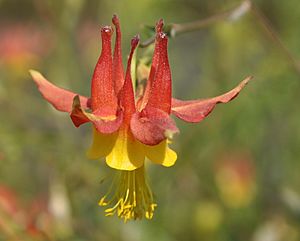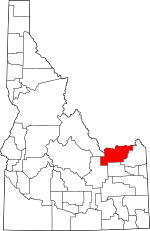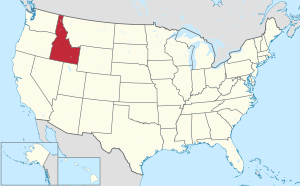Clark County, Idaho facts for kids
Quick facts for kids
Clark County
|
||
|---|---|---|

|
||
|
||

Location within the U.S. state of Idaho
|
||
 Idaho's location within the U.S. |
||
| Country | ||
| State | ||
| Founded | February 1, 1919 | |
| Named for | Sam K. Clark (1857–1933), state senator & pioneer |
|
| Seat | Dubois | |
| Largest city | Dubois | |
| Area | ||
| • Total | 1,765 sq mi (4,570 km2) | |
| • Land | 1,764 sq mi (4,570 km2) | |
| • Water | 1.0 sq mi (3 km2) 0.1% | |
| Population
(2020)
|
||
| • Total | 790 | |
| • Estimate
(2022)
|
806 |
|
| • Density | 0.56/sq mi (0.22/km2) | |
| Time zone | UTC−7 (Mountain) | |
| • Summer (DST) | UTC−6 (MDT) | |
| Congressional district | 2nd | |
Clark County is a rural county in the U.S. state of Idaho; its county seat and largest city is Dubois. As of the 2020 census, the population was 790, making it the least populous county in the state.
Contents
History
Establishment of stage coach stops along the route between Salt Lake City and the Montana mining towns were established at Beaver Canyon (named after Beaver Creek (Camas Creek) ) and Dry Creek (now Dubois) in 1864. Originally part of Alturas County, both locations were transferred to Oneida County in 1877. They became part of Bingham County at its creation in 1885. Clark County was also the site of the Battle of Camas Creek during the Nez Perce War which occurred at Camas Meadows near Kilgore on August 20, 1872. The Utah and Northern Railway reached Beaver Canyon in 1879. By the 1890 Census, Beaver Canyon had a population of 216. The settlement relocated to Spencer in 1897.
The majority of Clark County was transferred to Fremont County when it was created in 1893 with the remaining territory being transferred in 1896. By the 1900 Census, 1,199 residents lived in the five precincts of Birch Creek, Dubois, Kilgore, Medicine Lodge, and Spencer. At the 1910 census, the precincts contained 1,095 residents.
Dry Creek was renamed Dubois in 1892 and incorporated prior to 1920, while Spencer was incorporated in 1947.
The county was established 106 years ago in 1919, partitioned from Fremont County by the state legislature; the county division bill was signed by Governor D. W. Davis on February 1. It was named for state senator Sam K. Clark, an early pioneer on Medicine Lodge Creek in the upper Snake River valley.
Geography
According to the United States Census Bureau, the county has a total area of 1,765 square miles (4,570 km2), of which 1,764 square miles (4,570 km2) is land and 1.0 square mile (2.6 km2) (0.1%) is water.
The northern border of the county is the Bitterroot Range of the Rocky Mountains, which forms the state line with Montana and is also the continental divide. It is crossed by Interstate 15 over Monida Pass at 6,820 feet (2,080 m) above sea level. Monida Pass also marks an east–west divide between Bitterroot subranges: the Beaverhead Mountains are to the west and the Centennial Mountains are to the east.
Adjacent counties
- Lemhi County – west
- Butte County – southwest
- Jefferson County – south
- Fremont County – east
- Beaverhead County, Montana – north
Major highways
 Interstate 15 – Monida Pass
Interstate 15 – Monida Pass SH-22
SH-22
National protected areas
- Caribou-Targhee National Forest (part)
- Nez Perce National Historical Park (part)
- Salmon-Challis National Forest (part)
Demographics
| Historical population | |||
|---|---|---|---|
| Census | Pop. | %± | |
| 1920 | 1,886 | — | |
| 1930 | 1,122 | −40.5% | |
| 1940 | 1,005 | −10.4% | |
| 1950 | 918 | −8.7% | |
| 1960 | 915 | −0.3% | |
| 1970 | 741 | −19.0% | |
| 1980 | 798 | 7.7% | |
| 1990 | 762 | −4.5% | |
| 2000 | 1,022 | 34.1% | |
| 2010 | 982 | −3.9% | |
| 2020 | 790 | −19.6% | |
| 2023 (est.) | 801 | −18.4% | |
| U.S. Decennial Census 1790–1960 1900–1990 1990–2000 2010–2020 |
|||
2010 census
As of the 2010 census, there were 982 people, 345 households, and 243 families living in the county. The population density was 0.6 inhabitants per square mile (0.23/km2). There were 531 housing units at an average density of 0.3 per square mile (0.12/km2). The racial makeup of the county was 72.4% white, 1.0% American Indian, 0.7% black or African American, 0.5% Asian, 23.8% from other races, and 1.5% from two or more races. Those of Hispanic or Latino origin made up 40.5% of the population. In terms of ancestry, 14.8% were English, 7.4% were German, and 6.5% were American.
Of the 345 households, 37.7% had children under the age of 18 living with them, 57.4% were married couples living together, 7.0% had a female householder with no husband present, 29.6% were non-families, and 24.3% of all households were made up of individuals. The average household size was 2.84 and the average family size was 3.41. The median age was 32.7 years.
The median income for a household in the county was $40,909 and the median income for a family was $37,656. Males had a median income of $32,895 versus $24,125 for females. The per capita income for the county was $19,737. About 8.7% of families and 11.3% of the population were below the poverty line, including 21.5% of those under age 18 and 5.9% of those age 65 or over.
Education
The sole school district in the county is Clark County School District #161, headquartered in Dubois. Clark County High School competes in athletics in the Rocky Mountain Conference in IHSAA 1A Division II; the school colors are orange and black and its mascot is a bobcat.
The College of Eastern Idaho includes this county in its catchment zone; however, this county is not in its taxation zone.
Communities
Incorporated communities
Unincorporated communities
See also
 In Spanish: Condado de Clark (Idaho) para niños
In Spanish: Condado de Clark (Idaho) para niños


